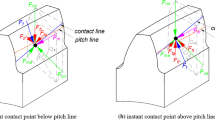Abstract
This work investigates the dynamic responses of a pair of helical gears considering the interaction between friction and time-varying mesh stiffness (TVMS). Firstly, governing equations with 8 degree-of-freedom, including friction excitations, are established. Then, the calculation methods for friction excitation and TVMS including friction are briefly introduced and influences of working conditions such as surface roughness, transmitted load and rotating speed on coefficient of friction, TVMS of a helical gear pair are revealed. Next, dynamic responses under steady state through numerical algorithm are obtained and the effects of the interaction between friction and TVMS are discussed under different working conditions. The results indicate that the effect brought by the interaction on dynamic responses except the linear vibration displacement along off-line-of-action is not consistent in a whole meshing period, and related to specific working condition. This work provides a more comprehensive way to understand dynamics behaviors of gear pairs.













Similar content being viewed by others
References
Ma H, Song R, Pang X et al (2014) Time-varying mesh stiffness calculation of cracked spur gears. Eng Fail Anal 44:179–194
Ma H, Zeng J, Feng R et al (2015) Review on dynamics of cracked gear systems. Eng Fail Anal 55:224–245
Wu Y, Wang J, Han Q (2012) Contact finite element method for dynamic meshing characteristics analysis of continuous engaged gear drives. J Mech Sci Technol 26(6):1671–1685
Ma H, Pang X, Feng R et al (2015) Fault features analysis of cracked gear considering the effects of the extended tooth contact. Eng Fail Anal 48:105–120
Munro RG, Palmer D, Morrish L (2001) An experimental method to measure gear tooth stiffness throughout and beyond the path of contact. Proc IMechE C J Mech Eng Sci 215(7):793–803
Pandya Y, Parey A (2013) Experimental investigation of spur gear tooth mesh stiffness in the presence of crack using photoelasticity technique. Eng Fail Anal 34:488–500
Raghuwanshi N, Parey A (2018) Experimental measurement of mesh stiffness by laser displacement sensor technique. Measurement 128:63–70
Ma H, Zeng J, Feng R et al (2016) An improved analytical method for mesh stiffness calculation of spur gears with tip relief. Mech Mach Theory 98:64–80
Ma H, Feng M, Li Z et al (2017) Time-varying mesh characteristics of a spur gear pair considering the tip-fillet and friction. Meccanica 52:1695–1709
Sun Y, Ma H, Huangfu Y et al (2018) A revised time-varying mesh stiffness model of spur gear pairs with tooth modifications. Mech Mach Theory 129:261–278
Chang L, Liu G, Wu L (2015) A robust model for determining the mesh stiffness of cylindrical gears. Mech Mach Theory 87:93–114
Huangfu Y, Chen K, Ma H et al (2019) Investigation on meshing and dynamic characteristics of spur gears with tip relief under wear fault. Sci China Technol Sci. https://doi.org/10.1007/s11431-019-9506-5
Chen K, Huangfu Y, Ma H et al (2019) Calculation of mesh stiffness of spur gears considering complex foundation types and crack propagation paths. Mech Syst Signal Process 130:273–292
Wan Z, Cao H, Zi Y et al (2015) Mesh stiffness calculation using an accumulated integral potential energy method and dynamic analysis of helical gears. Mech Mach Theory 92:447–463
Feng M, Ma H, Li Z et al (2018) An improved analytical method for calculating time-varying mesh stiffness of helical gears. Meccanica 53:1131–1145
Wang Q, Zhao B, Fu Y et al (2018) An improved time-varying mesh stiffness model for helical gear pairs considering axial mesh force component. Mech Syst Signal Process 106:413–429
Huangfu Y, Chen K, Ma H et al (2019) Deformation and meshing stiffness analysis of cracked helical gear pairs. Eng Fail Anal 95:30–46
Han L, Xu L, Qi H (2017) Influences of friction and mesh misalignment on time-varying mesh stiffness of helical gears. J Mech Sci Technol 31(7):3121–3130
He S, Singh R (2008) Dynamic transmission error prediction of helical gear pair under sliding friction using Floquet theory. ASME J Mech Des 130:052603-1–052603-9
Wei J, Gao P, Hu X et al (2014) Effects of dynamic transmission errors and vibration stability in helical gears. J Mech Sci Technol 28(6):2253–2262
Jiang H, Shao Y, Mechefske C (2014) Dynamic characteristics of helical gears under sliding friction with spalling defect. Eng Fail Anal 39:92–107
Jiang H, Liu F (2016) Dynamic features of three-dimensional helical gears under sliding friction with tooth breakage. Eng Fail Anal 70:305–322
Brethee K, Gu F, Ball A (2016) Frictional effects on the diagnostics of helical gear tooth defects. In: IncoME 2016, 30th–31st Augues 2016, Manchester Conference Centre, Manchester
Wang Q, Li Z, Ma H et al (2017) Effects of different coupling models of a helical gear system on vibration characteristics. J Mech Sci Technol 31(5):2143–2154
Xu H (2005) Development of a generalized mechanical efficiency prediction methodology for gear pairs. Doctor of Philosophy, Ohio State University, Ohio, USA
He S, Cho S, Singh R (2008) Prediction of dynamic friction forces in spur gears using alternate sliding friction formulations. J Sound Vib 309:843–851
Pedrero J, Pleguezuelos M, Artes M et al (2010) Load distribution model along the line of contact for involute external gears. Mech Mach Theory 45:780–794
Han L, Niu W, Zhang D et al (2013) An improved algorithm for calculating friction force and torque in involute helical gears. Math Probl Eng, Article ID 575302
He S, Gunda R, Singh R (2007) Effect of friction on the dynamics of spur gear pair with realistic time-varying stiffness. J Sound Vib 301:927–949
Funding
This study was funded by Natural Science Foundation of Tianjin (Grant No. 18JCQNJC75200) and Tianjin Municipal Education Commission (Grant No. JWK1601), China.
Author information
Authors and Affiliations
Corresponding author
Ethics declarations
Conflict of interest
The authors declare that they have no conflict of interest.
Additional information
Publisher's Note
Springer Nature remains neutral with regard to jurisdictional claims in published maps and institutional affiliations.
Rights and permissions
About this article
Cite this article
Han, L., Qi, H. Dynamic response analysis of helical gear pair considering the interaction between friction and mesh stiffness. Meccanica 54, 2325–2337 (2019). https://doi.org/10.1007/s11012-019-01088-y
Received:
Accepted:
Published:
Issue Date:
DOI: https://doi.org/10.1007/s11012-019-01088-y



